35+ Double Negative Examples
In the vast world of language and grammar, double negatives hold a unique place. They are often misunderstood and misused, leading to confusion and miscommunication. This article aims to demystify double negatives, providing you with downloadable examples and quiz templates to help you master this intriguing grammatical concept. We’ll also guide you through the process of using double negatives correctly, and answer some frequently asked questions on the topic.
What is a Double Negative?
A double negative occurs when two negative words are used in the same clause, leading to a construction that can either contradict itself or create an unintended positive meaning. This linguistic feature is common in some dialects and informal speech, but it is typically considered incorrect in standard English grammar. Understanding double negatives is essential for clear and effective communication.
How Double Negatives Work
In standard English, a single negative is sufficient to negate a statement. When two negatives are used together, they can cancel each other out, resulting in a positive statement, which can cause confusion for the reader or listener. The two negative elements can include negative words like “not,” “no,” “never,” “nothing,” “nowhere,” and negative prefixes like “un-” and “dis-.”
Examples of Double Negatives
- Incorrect:
- “I don’t know nothing about it.”
- Explanation: The double negatives “don’t” and “nothing” cancel each other out, implying that the speaker does know something about it.
- Corrected:
- “I don’t know anything about it.”
- “I know nothing about it.”
- Incorrect:
- “She can’t find nowhere to sit.”
- Explanation: The double negatives “can’t” and “nowhere” imply that she can find somewhere to sit.
- Corrected:
- “She can’t find anywhere to sit.”
- “She can find nowhere to sit.”
- Incorrect:
- “We don’t need no education.”
- Explanation: The double negatives “don’t” and “no” imply that education is needed.
- Corrected:
- “We don’t need any education.”
- “We need no education.”
Purposeful Use of Double Negatives
In some dialects and informal contexts, double negatives are used intentionally for emphasis or stylistic reasons. This usage is often found in certain regional dialects, African American Vernacular English (AAVE), and various forms of artistic expression, such as music and literature.
Example:
- “Ain’t nobody got time for that.”
- Explanation: This sentence uses a double negative for emphasis, commonly found in informal speech.
Double Negative Examples
- I don’t know nothing about it.
- She can’t find nowhere to sit.
- We don’t need no education.
- He didn’t say nothing about the meeting.
- I can’t hardly believe it.
- They don’t have no time to waste.
- You shouldn’t do nothing about it.
- There isn’t nobody who can help.
- We don’t have no choice.
- He can’t go nowhere without his phone.
Double Negative Words
| no | none | never | nothing |
| not | nobody | nowhere | neither |
| can’t | isn’t | doesn’t | didn’t |
| won’t | couldn’t | wouldn’t | haven’t |
| shouldn’t | wasn’t | weren’t | hasn’t |
| ain’t | don’t | hadn’t | rarely |
List Double Negative Sentence Examples
- I can’t find my keys nowhere.
- She hasn’t done nothing all day.
- We didn’t get no mail today.
- He won’t tell nobody his secret.
- I can’t see nothing in this darkness.
- They didn’t go nowhere for vacation.
- You shouldn’t leave nothing on the table.
- There aren’t no cookies left in the jar.
- We won’t have no problems if we follow the rules.
- She couldn’t hear nobody calling her.
1. Simple Double Negative Example
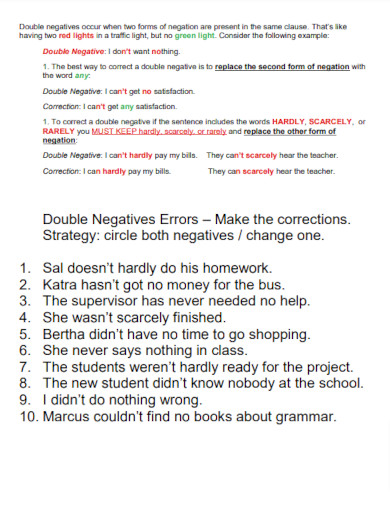
mymission.lamission.edu
2. Understanding Double Negatives
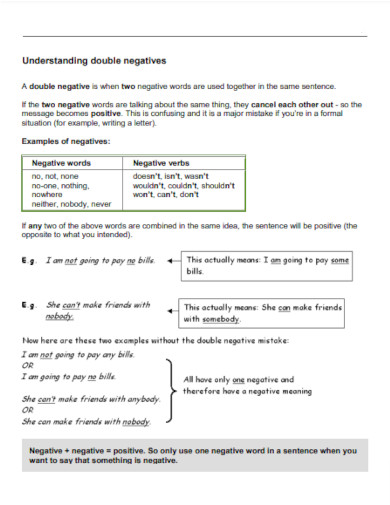
teach.files.bbci.co.uk
3. Double Negation and the Pleonastic
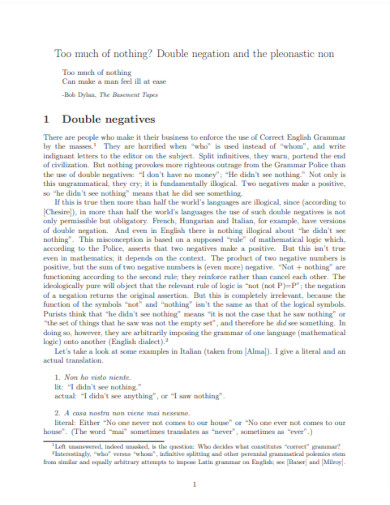
sites.math.washington.edu
4. Sample Double Negative Quiz Example
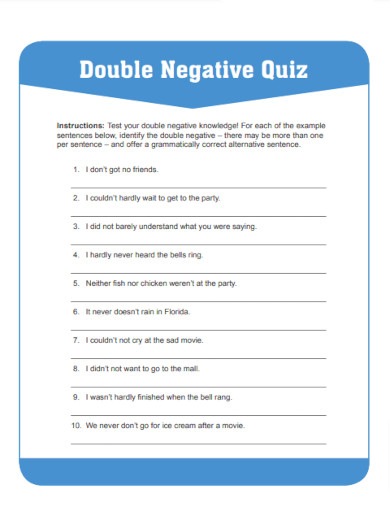
assets.ltkcontent.com
5. Correcting Double Negatives Example
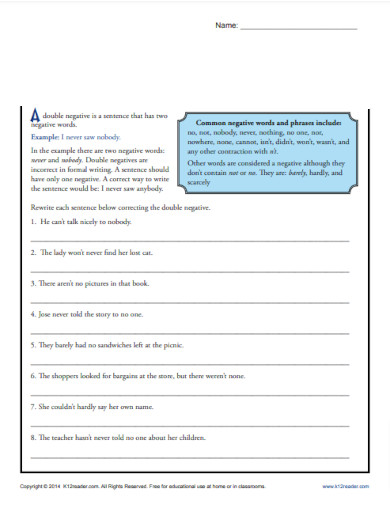
mrgillett.weebly.com
6. Avoiding Double Negatives Example
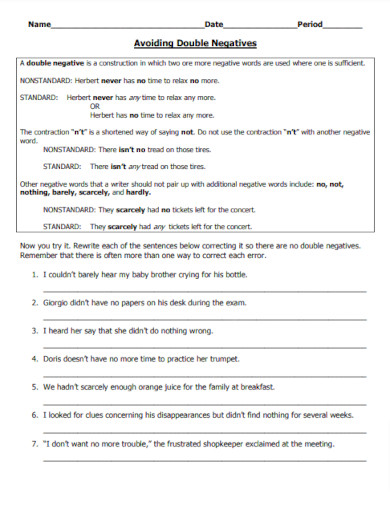
warrencountyschools.org
7. Double Negatives Line Example
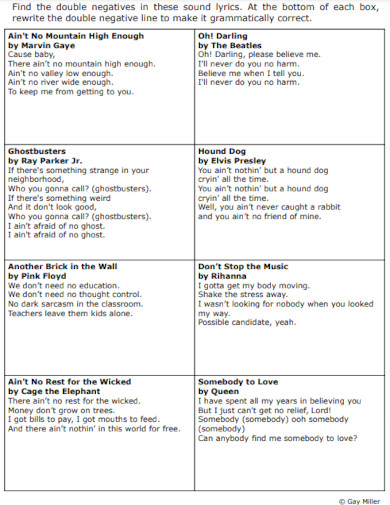
bookunitsteacher.com
8. Basic Double Negatives Example
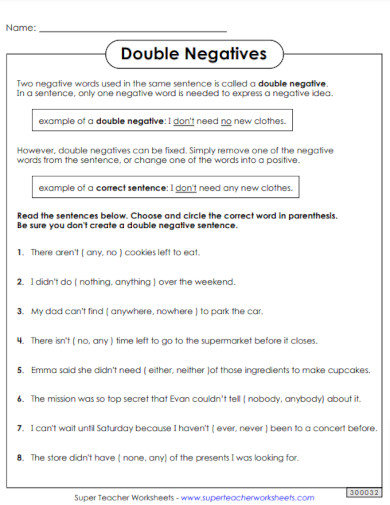
superteacherworksheets.com
9. Editable Double Negative Example
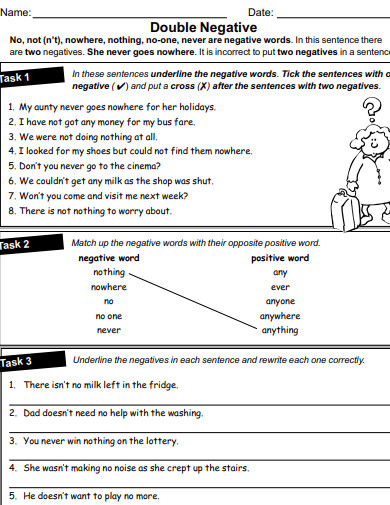
rotherhitheprimary.co.uk
Modern Double Negatives Example
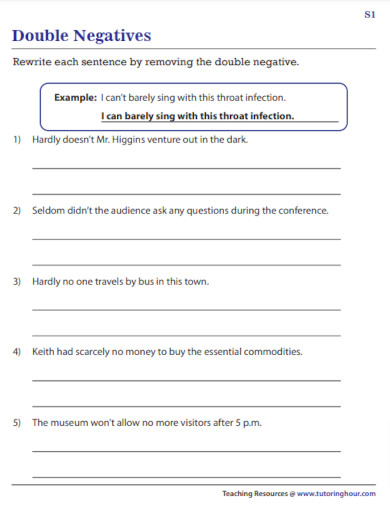
tutoringhour.com
10. Comparing the Weak Positive and Negative Concord
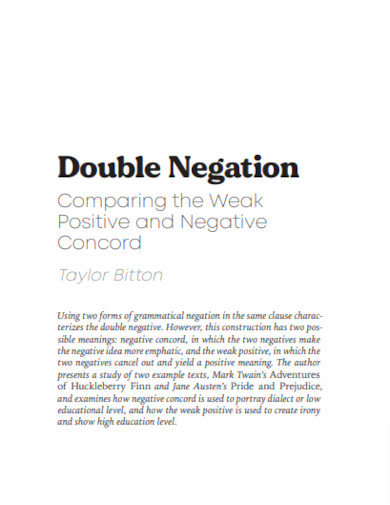
schwa.byu.edu
Fixing Double Negatives
1. Identify the Negative Words
- Look for words that indicate negation, such as “no,” “not,” “never,” “nothing,” “nowhere,” “nobody,” “none,” “can’t,” “won’t,” “didn’t,” etc.
2. Determine the Intended Meaning
- Understand what the sentence is trying to convey. Determine if the intent is to negate or affirm something.
3. Remove One of the Negatives
- Choose which negative word to remove based on the intended meaning. Usually, replace one of the negatives with a positive word or its corresponding positive form.
4. Replace with Positive Words (if necessary)
- Replace the second negative word with an appropriate positive word or phrase, such as “anything,” “anyone,” “anywhere,” “something,” etc.
5. Ensure Clarity and Correctness
- Read the revised sentence to ensure it clearly conveys the intended meaning without ambiguity.
Examples
- Identify the Negative Words:
- Original: “I can’t find my keys nowhere.”
- Negatives: “can’t” and “nowhere”
- Determine the Intended Meaning:
- Intended meaning: “I can’t find my keys anywhere.”
- Remove One of the Negatives:
- Decide to keep “can’t” and replace “nowhere.”
- Replace with Positive Words (if necessary):
- Revised: “I can’t find my keys anywhere.”
- Ensure Clarity and Correctness:
- Final: “I can’t find my keys anywhere.”
Example Revision Process
Example 1:
- Original: “She hasn’t done nothing all day.”
- Identify Negatives: “hasn’t” and “nothing”
- Intended Meaning: “She hasn’t done anything all day.”
- Remove One Negative: Keep “hasn’t” and replace “nothing.”
- Replace with Positive: “anything”
- Final: “She hasn’t done anything all day.”
Example 2:
- Original: “We didn’t get no mail today.”
- Identify Negatives: “didn’t” and “no”
- Intended Meaning: “We didn’t get any mail today.”
- Remove One Negative: Keep “didn’t” and replace “no.”
- Replace with Positive: “any”
- Final: “We didn’t get any mail today.”
How to Use Double Negatives
Before we delve into the steps, it’s important to understand that double negatives are often used in literature as literary devices to add depth and complexity to the text. They can also be found in everyday speech, particularly in certain dialects and colloquial language.
Step 1: Understand the Purpose
The first step in using double negatives is to understand their purpose. In a Simple Sentence, a double negative can create an ironic or sarcastic tone, or it can be used to emphasize a point. In literature, it can contribute to the theme or element of the story.
Step 2: Identify the Negative Words
Identify the negative words in your sentence. These could be verbs, adverbs, pronouns, or even prefixes. Understanding the text structure can help you identify these words more easily.
Step 3: Construct the Double Negative
Once you’ve identified the negative words, construct your double negative. Remember, in standard English, two negatives make a positive. For example, in the Fused Sentence, “I can’t hardly wait,” the double negative implies that the speaker can indeed wait.
Step 4: Check for Clarity
Finally, check your sentence for clarity. Make sure the tone is clear and the double negative doesn’t confuse the reader. If you’re using it as a direct object, ensure it doesn’t disrupt the flow of the sentence.
Are double negatives grammatically correct?
Yes, double negatives are grammatically correct, especially when used as a stylistic choice in literature or to emphasize a point. However, in formal writing and standard English, they can lead to confusion as two negatives create a positive statement.
Can double negatives be used in formal writing?
While double negatives are not typically used in formal writing, they can be used for emphasis or to convey a specific tone. However, they should be used sparingly and with caution to avoid confusion.
How can I practice using double negatives?
Practicing double negatives can be done by writing sentences using negative verbs and other negative words. You can also download our quiz templates and examples for more practice.
What happens if you double a negative?
Doubling a negative number results in a larger negative value, while doubling a negative statement reinforces its negativity, making it more difficult to understand or less effective.
How to correct double negatives?
Correcting double negatives involves removing one negative word or replacing the double negatives with a single positive expression to make the sentence clear and grammatically correct.
How does 2 negatives equal a positive?
In mathematics, multiplying two negative numbers results in a positive number due to the rules of arithmetic operations, where negative signs cancel each other out.
Why are double negatives considered incorrect in English?
Double negatives are considered incorrect in standard English because they create confusion and ambiguity. Instead of reinforcing a negative meaning, they can unintentionally imply a positive meaning.
How do double negatives work in other languages?
In some languages, like Spanish and Italian, double negatives are grammatically correct and used to emphasize negativity. This linguistic feature is known as negative concord.
Can double negatives be used for emphasis?
In informal speech or certain dialects, double negatives are sometimes used for emphasis. However, they are generally avoided in formal writing to maintain clarity and correctness.
Are double negatives always incorrect in English?
While double negatives are typically considered incorrect in standard English, they are accepted in some regional dialects and informal speech, where they can convey a stronger negative meaning.
Double negatives, while often misunderstood, can be a powerful tool in both literature and everyday language. By understanding their purpose, identifying negative words, constructing the double negative, and checking for clarity, you can master the use of double negatives. Remember, practice makes perfect, so don’t hesitate to download our examples and quiz templates for further practice.


